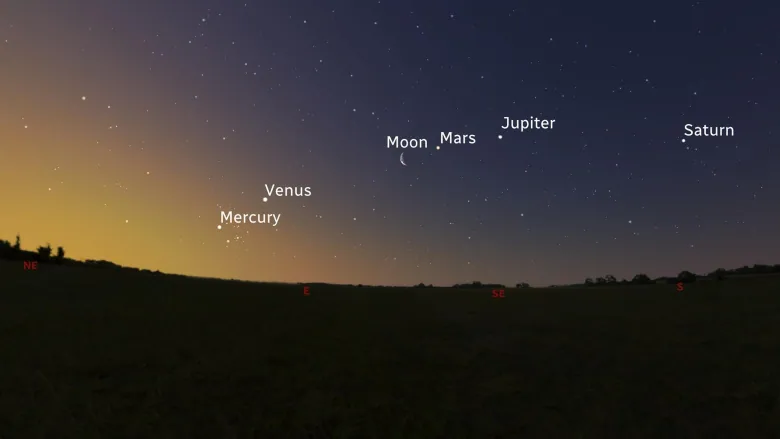If you’re a morning person, there’s a treat in the sky before sunrise: five of the sky’s brightest planets all lined up among the stars.
We can normally see the solar system’s brightest planets in the night sky throughout the year in their planetary dance. But it’s not often that they line up so spectacularly.
There’s another reason why this is special: the planets appear in the sky in the same order they are outward from the sun: Mercury, Venus, Mars, Jupiter and Saturn.
The best part is that you don’t even need a pair of binoculars to catch the show. But you will need a good view of the eastern horizon.
Where and when to look
The planetary pageant has been going on for a few weeks. But on Thursday, Mercury will be at its highest point in the eastern sky, making it just a little easier to see. That’s not to say that it’s high, though; it will only be roughly three degrees above the horizon.
The time to look is roughly an hour before sunrise. You can check sites like TimeandDate or The Weather Network for your local sunrise/sunset times.
The next planet outward from Mercury is the unmistakable Venus, the brightest planet in our night sky. It is slowly descending toward the horizon where it will eventually become visible in the evening sky in the fall.
Next in this lineup isn’t a planet at all, but a beautiful crescent moon, which will lie between Venus and Mars, the next planet in the show.
Mars isn’t exactly at its brightest, but you won’t be able to miss it for its reddish colour. You can easily find it to the left of the sky’s second-brightest planet, Jupiter, which — like Venus — is hard to miss.

And finally, there’s Saturn, which you can find higher in the southeast.
Of course, in reality these planets are still millions of kilometres apart, but their orbits just happen to place them in a prime viewing spot for us here on Earth.
While binoculars aren’t needed, if you have a pair, try checking out the planets. They may also help you find the much dimmer Mercury hugging the horizon. (Just be careful that you don’t get so caught up that you’re using binoculars when the sun comes up, as Mercury will be lost in its glare, and you may inadvertently look at the sun.)
What can be a lot of fun, however, is turning your binoculars to Jupiter, and in particular, doing so over a few days.
Jupiter’s four brightest moons — Callisto, Europa, Io and Ganymede — are easily seen through a modest pair of binoculars. The moons orbit the solar system’s giant so quickly that you can see them change positions night after night (and even over one night, if you have the patience).
To find out which moons you are looking at, you can check out Sky & Telescope’s Jupiter’s Moons page (there is also an app available for smartphones).


